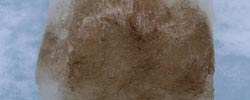Micro-gels from tiny Arctic and Antarctic ice algae play an important role in polar ocean carbon budgets

The ice algae secrete gel-like substances in response to environmental stress. New research show that this micro-gel play an important role in polar ocean carbon Budgets<br>(Photo: David Thomas)<br>
A community of microscopic algae and bacteria thrives within the Arctic and Antarctic pack ice. These ice-organisms are adapted to growing on the ice crystal surfaces and within a labyrinth of channels and pores that permeate the ice floes.
It is a hostile place to grow with temperatures often at -10°C to -20°C, low light and within six or seven times more salty brines in the ice channels compared to the underlying seawater from where these organisms originate.
Many marine organisms secrete gel-like substances in response to environmental stress, and these ice-dwellers are no exception. In fact they secrete large quantities of gels that are made up from various types of polysaccharides.
A new study released in Proceedings of the National Academy of Science, now demonstrate that these gels from ice-microorganisms are important in both the Arctic and Antarctic. It is likely that they will not only affect the physical structure within the ice but also how carbon travels to the ocean floor and even the weather.
Sticky masses
The gels promote the clumping together of cells when they are released from the ice when it melts. These sticky masses fall more rapidly to the sea floor, taking carbon (and food) out of the surfaces waters.
There is also evidence that micro-gels at the ocean surface may get caught up into the air and eventually act as cloud condensing nuclei thereby affecting weather. The gels therefore have profound implications for both the long-term burial of carbon to the ocean floor and thus the global carbon budget and on the weather.
Since 2006 Professor Graham Underwood & Dr Shazia Aslam from University of Essex and Professor David Thomas from Arctic Research Centre, Aarhus University have led several projects (funded by the Natural Environment Research Council, UK) to study the production of micro-gels, and their widespread importance to the frozen realms of the worlds oceans. They teamed up with colleagues from Australia and Canada to collect and analyse ice cores from both the Arctic and Antarctic.
Seven years on, and many frozen trips later, they now publish a rather surprising finding. Analysing ice data spanning ice from both the Arctic and Antarctic, they are now able to determine the amounts of gel production from the ice microbes based on data of the physical nature of the ice and the amount of microbiology.
“It means that we can estimate the concentration of gels in ice, by knowing rather routine measurements such as the thickness of the ice floes, temperature and salinity of the ice and the quantity of ice biology measured as the chlorophyll content of the ice,” says Professor David Thomas, Arctic Research Centre, Aarhus University.
“This is a huge step forwards to enable us to estimate the significance of these materials to the millions of square kilometres of Antarctic and Arctic pack ice”, says Thomas.
Contact:
Professor David Thomas
Arctic Research Centre
Department of Bioscience
Aarhus University
Tlf: +45 29653117
Email: david.thomas@biology.au.dk.
Publication: GJC Underwood, S Aslam, C Michel, A Niemi, L Norman, KM Meiners, J Laybourn-Parry, H Paterson & DN Thomas. 2013. Broad-scale predictability of carbohydrates and exopolymers in Antarctic and Arctic sea ice. Proceedings of the National Academy of Sciences of the United States of America, DOI 10.1073/pnas.1302870110
Media Contact
More Information:
http://www.au.dkAll latest news from the category: Life Sciences and Chemistry
Articles and reports from the Life Sciences and chemistry area deal with applied and basic research into modern biology, chemistry and human medicine.
Valuable information can be found on a range of life sciences fields including bacteriology, biochemistry, bionics, bioinformatics, biophysics, biotechnology, genetics, geobotany, human biology, marine biology, microbiology, molecular biology, cellular biology, zoology, bioinorganic chemistry, microchemistry and environmental chemistry.
Newest articles

Properties of new materials for microchips
… can now be measured well. Reseachers of Delft University of Technology demonstrated measuring performance properties of ultrathin silicon membranes. Making ever smaller and more powerful chips requires new ultrathin…

Floating solar’s potential
… to support sustainable development by addressing climate, water, and energy goals holistically. A new study published this week in Nature Energy raises the potential for floating solar photovoltaics (FPV)…

Skyrmions move at record speeds
… a step towards the computing of the future. An international research team led by scientists from the CNRS1 has discovered that the magnetic nanobubbles2 known as skyrmions can be…





















